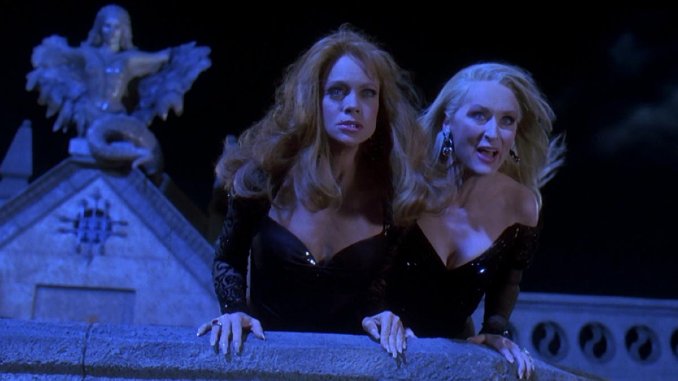The Queer Immortality of Death Becomes Her

Thunder and lightning crash as a nearly-nude sorceress pounces to her feet. “Screw the natural law!” she roars while an aging starlet cowers at her feet. There’s a twinkle in the sorceress’ eye; she holds an invitation, a promise to experience life differently. I’ve seen queer people talk about Death Becomes Her with similar ferocity while an unsuspecting heterosexual stands frozen. We will tower with superior enjoyment, arms outstretched, mad-eyed, heralding the movie’s excellence, despite all logic. Celebrating its 30th anniversary this year, the film initially received mixed to hostile receptions from critics. But in the years since, Death Becomes Her has gained a considerable and curiously queer following.
The film follows two frenemies, Madeline Ashton (Meryl Streep) and Helen Sharp (Goldie Hawn), who take an elixir of immortality. As their feud over the once-successful plastic surgeon Dr. Ernest Menville (Bruce Willis) finally climaxes, the pair find themselves on the other side of life—but not quite dead, either.
The queer canon is full of problematic faves, and Death Becomes Her is no exception. It intentionally does not like its women. During an interview included in the 2016 Blu-ray release, screenwriter David Koepp makes it quite plain that, as someone both “fascinated and revolted by Beverly Hills,” he wanted to write a story that would capture the “alien landscape filled with strange people who did strange things to their bodies.” As such, the film has no interest in redeeming Madeline or Helen.
Madeline, the “it,” remains a monster of pure artifice. Helen, in or out of a horrendous fat suit, remains of pure emotion. Though they seem to reconcile, neither changes for long. Instead, their grotesqueness manifests externally. These once vain creatures are fragile and ugly by the end, destined to continue their spayed cattiness for eternity.
Their wickedness is written directly opposed to Ernest’s innocence and fragility. These women do the worst thing you could do to a man in an early 1990s studio comedy: Emasculate him. Once a celebrated plastic surgeon, he’s reduced to an undertaker with an unsteady drinker’s hand, presumably because Madeline has driven him to the bottle. And it’s his wife’s barbed comment about his “flaaacid” penis that drives him to the literal ledge and commit murder. Well, “attempted” murder.
With all this Freudian castration anxiety lingering about and the way these female characters carry decades of sexist clichés, there seems plenty to laugh at with these characters, but not necessarily laugh about with them. Koepp never wants our laughter to transform into celebration. Just like Ernest at Madeline’s musical, it’s considered weird for us to clap and cheer at these performances because it goes against the grain of the text. For Koepp, it’s like rooting for Frankenstein’s creation. So what is it about Death Becomes Her that allows for queer enjoyment? How can there be anything queer in a film which, according to the screenwriter, has “don’t be unnatural” as its moral center?
There’s a long history of monsters and queers identifying with each other. Both are called “unnatural” because they defy social boundaries said to be found within a divine order. Monsters like the ones made by Victor Frankenstein or painted by Ernest Menville walk the supposedly firm line between living and dead. Queer people similarly skirt hardened sexual and gender lines. It’s a logical link that a queer appreciation of Death Becomes Her begins with a willing identification with its monstrous characters.
What makes this appreciation take hold so easily are the central performances. Everyone is acting their asses off in Death Becomes Her, not just Meryl. Willis sews together character traits that are totally against type. Ernest is frail and flailing; he screeches and wails. Unlike the macho characters Willis built his career on, Ernest is entirely devoid of any “yippee ki-yay.”
Of our leading performers, Goldie Hawn remains the most in her wheelhouse. She delivers exactly what we expect, a sharp and emotional sense of humor that pierces every line reading. So rarely do we get to see Hawn use her talents for evil, but Helen is no airhead blonde. She’s a wicked sniper with self-possessed sexuality, which is how Hawn gets to play against her image.
Streep turns your head around with all the directions she finds for her character. Though she’d dabbled in comedies before, Death Becomes Her allows Streep to go broad. Streep casts off the shackles of naturalism and gives a grand, coarse and fanciful performance, unlike anything we’ve seen from her before or since.
The lover’s triangle works exceedingly well together. Everyone seems to be having a genuine ball being awful people. We could stop here and conclude that the queer enjoyment of Death Becomes Her is found in an identification with the monstrous and hyper/self-performance. But even if these actresses are having fun and showcasing talent despite the script, such enjoyment still allows the sexism and homophobia of the film to remain unchallenged.
-

-

-

-

-

-

-

-

-

-

-

-

-

-

-

-

-

-

-

-

-

-

-

-

-

-

-

-

-

-

-

-

-

-

-

-

-

-

-

-








































